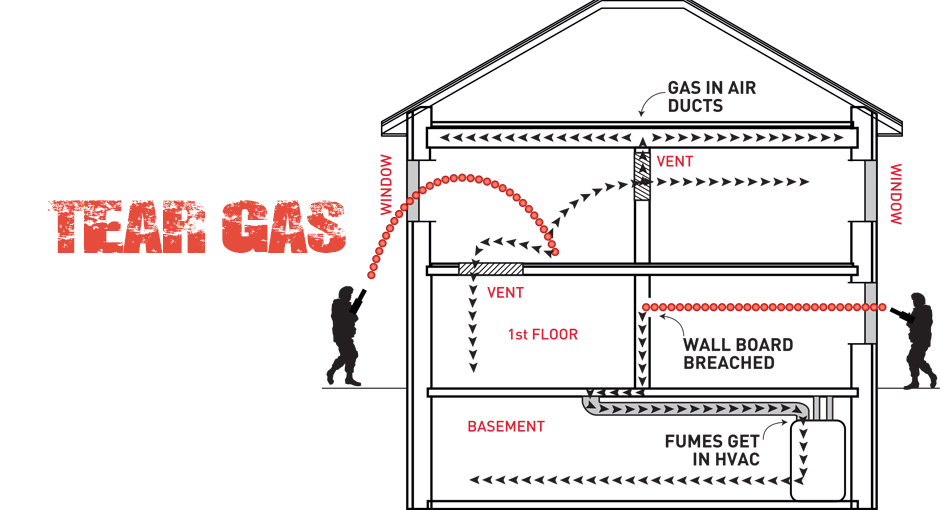How to Clean Tear Gas
If you’ve been exposed to tear gas, your first priority is to remove it from your eyes, face, and surrounding area as quickly as possible. Acting swiftly can help reduce the discomfort and potential harm. Below are some practical tips for safely and effectively removing tear gas from yourself and your environment.
Removing Tear Gas from Your Eyes and Body
Tear gas can inflict pain within seconds, so knowing what to do once you have been a victim of tear gas can ensure you make it to safety.
- Hold your breath. Breathing in tear gas causes extreme chest pain, increased mucus production, and vomiting.
- Close your eyes. But how will I see? While not every situation allows for this, closing your eyes when you can helps keep the tiny CS particles from entering your eyes and tear ducts.
- Get out of there. The faster you remove yourself from the area, the sooner you will gain relief from the pain.
- Rinse your eyes. While rinsing your eyes from the inner to the outer corner, avoid allowing the contaminated water to run onto your skin or clothes. If you wear contacts, be sure to remove them prior to rinsing your eyes.
- Wash your hands. This will ensure you do not recontaminate your eyes and face and will prevent you from contaminating other people with whom you come into contact.
- Change your clothes. If this is not an immediate option, gently pat down your clothes while facing the wind so that the particles do not blow back into your face and eyes.
- Take a cold shower. Hot water will open your pores and allow the chemicals to seep further in, resulting in even more irritation.
If you’re in need of immediate assistance, call 24/7/365
Knowing the type of tear gas you’re dealing with is crucial for both individuals impacted and first responders for several reasons:
- Health Risks and Severity: Different tear gasses have varying levels of potency and effects on the body. For example, CS gas primarily causes temporary irritation, while CR gas can lead to more severe and prolonged symptoms. Understanding the type helps assess the immediate health risks and determine the appropriate level of care.
- Decontamination Process: The chemical composition of each tear gas influences the decontamination methods required. Some tear gasses, like CR gas, are harder to remove from the skin and clothing, necessitating more thorough cleaning procedures. Knowing the type ensures that the right decontamination steps are taken to reduce prolonged exposure and prevent further harm.
- Medical Treatment: Certain tear gasses may require specific medical interventions. For instance, exposure to OC gas (pepper spray) might be treated differently than exposure to CS gas, especially if someone has pre-existing respiratory conditions. Identifying the type of gas can guide first responders in administering the most effective treatment.
- Safety Precautions: Different tear gasses have different safety considerations. For example, PAVA (synthetic pepper spray) is more controlled in its effects but can still pose serious risks if not handled properly. Knowing the specific tear gas helps first responders take appropriate precautions to protect themselves and others during the response.
- Legal and Documentation Purposes: For first responders, accurately identifying the type of tear gas used is important for legal documentation and reporting. This information can be vital in investigations, legal proceedings, and understanding the context of the situation.
Overall, being aware of the specific type of tear gas involved ensures that individuals and first responders can respond appropriately, minimizing harm and ensuring effective treatment and decontamination. Here are the most common types of tear gasses:
CS Gas (2-Chlorobenzalmalononitrile)
- Common Name: CS Gas
- Overview: CS gas is the most widely used tear gas by law enforcement. It causes a burning sensation in the eyes, nose, and throat, leading to tears, coughing, and difficulty breathing.
CN Gas (Chloroacetophenone)
- Common Name: Mace
- Overview: CN gas is an older type of tear gas and is less commonly used today. It has a more potent irritant effect on the eyes than CS gas but is considered less effective overall.
CR Gas (Dibenzoxazepine)
- Common Name: CR Gas
- Overview: CR gas is more potent than CS gas and is known to be more difficult to remove from the skin. It can cause severe irritation and pain in the eyes and skin.
OC Gas (Oleoresin Capsicum)
- Common Name: Pepper Spray
- Overview: OC gas, commonly known as pepper spray, is derived from chili peppers. It causes intense burning in the eyes, skin, and respiratory system. While technically not a gas, it is often grouped with tear gasses due to its similar effects.
PAVA (Pelargonic Acid Vanillylamide)
- Common Name: Synthetic Pepper Spray
- Overview: PAVA is a synthetic form of OC gas and is used in some law enforcement pepper sprays. It has similar effects to natural pepper spray but is often considered more controlled and consistent in its potency.
Removing Tear Gas from an Enclosed Area

If your home, property, or business has been tear gassed, you want to restore the environment as quickly as possible. But how? Using state-of-the-art technology and strict control procedures, Aftermath carefully washes affected surface areas and performs structural remediation to remove damaged floors, walls, and surface coverings to thoroughly and safely restore the scene. Aftermath is a nationwide industry leader in biohazard, trauma, and tear gas cleaning with a dedication to maintaining the highest industry standards while protecting the safety of our employees and those we serve. Contact us for more information.
 877-872-4339
877-872-4339  Contact Us
Contact Us 






